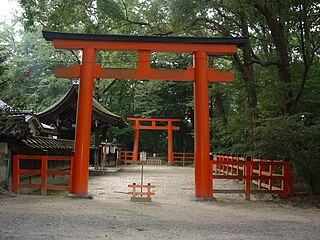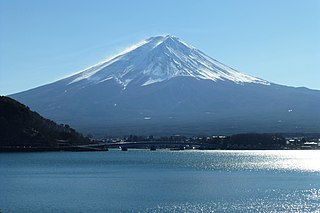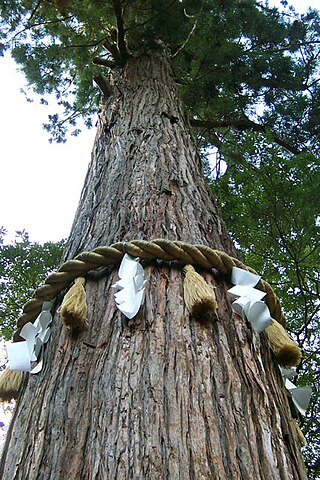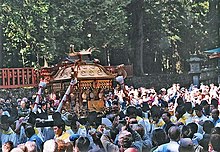Kami are the deities, divinities, spirits, mythological, spiritual, or natural phenomena that are venerated in the Shinto religion. They can be elements of the landscape, forces of nature, beings and the qualities that these beings express, and/or the spirits of venerated dead people. Many kami are considered the ancient ancestors of entire clans. Traditionally, great leaders like the Emperor could be or became kami.

Shinto is a religion originating in Japan. Classified as an East Asian religion by scholars of religion, its practitioners often regard it as Japan's indigenous religion and as a nature religion. Scholars sometimes call its practitioners Shintoists, although adherents rarely use that term themselves. There is no central authority in control of Shinto, with much diversity of belief and practice evident among practitioners.

Japanese festivals are traditional festive occasions often celebrated with dance and music in Japan. In Japan, festivals are called matsuri (祭り), and the origin of the word matsuri is related to the kami; there are theories that the word matsuri is derived from matsu (待つ) meaning "to wait ", tatematsuru (献る) meaning "to make offerings to the kami", and matsurau (奉う) meaning "to obey the kami". The theory that it is derived from matsurau is the most popular.

Isonokami Shrine is a Shinto shrine located in the hills of Furu in Tenri, Nara prefecture, Japan. It is one of the oldest extant Shinto shrines in Japan and has housed several significant artifacts.

A Shinto shrine is a structure whose main purpose is to house ("enshrine") one or more kami, the deities of the Shinto religion.

Yasaka Shrine, once called Gion Shrine, is a Shinto shrine in the Gion District of Kyoto, Japan. Situated at the east end of Shijō-dōri, the shrine includes several buildings, including gates, a main hall and a stage. The Yasaka shrine is dedicated to Susanoo in the tradition of the Gion faith as its chief kami, with his consort Kushinadahime on the east, and eight offspring deities on the west. The yahashira no mikogami include Yashimajinumi no kami, Itakeru no kami, Ōyatsuhime no kami, Tsumatsuhime no kami, Ōtoshi no kami, Ukanomitama no kami, Ōyatsuhiko no kami, and Suseribime no mikoto.

The Gion Festival is one of the largest and most famous festivals in Japan, taking place annually during the month of July in Kyoto. Many events take place in central Kyoto and at the Yasaka Shrine, the festival's patron shrine, located in Kyoto's famous Gion district, which gives the festival its name. It is formally a Shinto festival, and its original purposes were purification and pacification of disease-causing entities. There are many ceremonies held during the festival, but it is best known for its two Yamaboko Junkō (山鉾巡行) processions of floats, which take place on July 17 and 24.

Kamo Shrine is a general term for an important Shinto sanctuary complex on both banks of the Kamo River in northeast Kyoto. It is centered on two shrines. The two shrines, an upper and a lower, lie in a corner of the old capital which was known as the "devil's gate" due to traditional geomancy beliefs that the north-east corner brought misfortune. Because the Kamo River runs from the north-east direction into the city, the two shrines along the river were intended to prevent demons from entering the city.

Shimenawa are lengths of laid rice straw or hemp rope used for ritual purification in the Shinto religion.

In Shinto shrine architecture, the honden, also called shinden (神殿), or sometimes shōden (昇殿) as in Ise Shrine's case, is the most sacred building at a Shinto shrine, intended purely for the use of the enshrined kami, usually symbolized by a mirror or sometimes by a statue. The building is normally in the rear of the shrine and closed to the general public. In front of it usually stands the haiden, or oratory. The haiden is often connected to the honden by a heiden, or hall of offerings.

Suwa Shrine is the major Shinto shrine of Nagasaki, Japan, and one of the major locations of the Nagasaki Kunchi, originally celebrated on the ninth day of the ninth lunar month and now celebrated on the fixed dates of October 7 to October 9. It is located in the northern part of the city, on the slopes of Mount Tamazono, and features a 277-step stone staircase leading up the mountain to the various buildings that comprise the shrine.

Aso Shrine is a Shinto Shrine in Aso, Kumamoto Prefecture, Japan. Aso is one of the oldest shrines in Japan. This shrine holds several Important Cultural Properties, including Ichi-no-shinden (一の神殿), Ni-no-shinden (二の神殿), and Rōmon (楼門). The Aso family in charge of the shrine is said to have the second oldest recorded lineage in Japan after the Imperial family. The Aso Shrine was heavily damaged in the 2016 Kumamoto earthquakes. The shrine's rōmon completely collapsed. The haiden also collapsed.
This is the glossary of Shinto, including major terms on the subject. Words followed by an asterisk (*) are illustrated by an image in one of the photo galleries.

Ōmiwa Shrine, also known as Miwa Shrine, is a Shinto shrine located in Sakurai, Nara Prefecture, Japan. The shrine is noted because it contains no sacred images or objects because it is believed to serve Mount Miwa, the mountain on which it stands. For the same reason, it has a worship hall, but no place for the deity to be housed. In this sense, it is a model of what the first Shinto shrines were like. Ōmiwa Shrine is one of the oldest extant Shinto shrines in Japan and the site has been sacred ground for some of the earliest religious practices in Japan. Because of this, it has sometimes been named as Japan's first shrine. Ōmiwa Shrine is a tutelary shrine of the Japanese sake brewers.

In Shinto, shintai, or go-shintai when the honorific prefix go- is used, are physical objects worshipped at or near Shinto shrines as repositories in which spirits or kami reside. Shintai used in Shrine Shinto can be also called mitamashiro.
The Niiname-sai is a Japanese harvest ritual.

A shinboku (神木) is a tree or forest worshipped as a shintai – a physical object of worship at or near a Shinto shrine, worshipped as a repository in which spirits or kami reside. They are often distinctly visible due to the shimenawa wrapped around them.

Gion worship is a Shinto cult. Originally it revolved solely around Gozu Tenno, but during the Separation of Shinto and Buddhism of the Meiji era the government mandated it shift to revolving around Susanoo.
Shinto is a religion native to Japan with a centuries'-long history tied to various influences in origin.

Hotaka Shrine is a Shinto shrine in Hotaka, Azumino, Matsumoto, Nagano Prefecture, Japan. It is one of the three main shrines in Shinano Province. The Engishiki Jinmyocho describes it as a Myojin Taisha and it is now a Beppyo shrine.

![Underwater shinko shiki at Yatsurugi Shrine [simple] Miyamatsuri.JPG](http://upload.wikimedia.org/wikipedia/commons/thumb/a/a4/Miyamatsuri.JPG/220px-Miyamatsuri.JPG)















